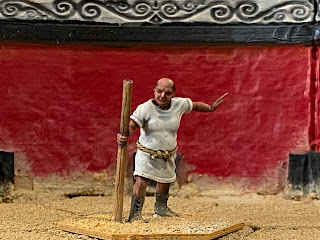I'm Spartacus
Next up it was time to expand on the available combatants.
First up, the Cestus.
The Cestus wear heavy knuckleduster type gloves but little or no armour. They were most often used in fights against slaves where they would literally beat their opponents to death.
Eventually they were banned because of the excessive brutality. Hard to imagine given how brutal the condemned were treated.
Next the Hoplomachus.
The Hoplomachus carried a spear, sword, and shield. Often with quilted armour on the legs. This is a heavily armoured fighter, and this is reflected in my rules by its slower speed but better protection. The spear can be thrown or used to attack its opponent whilst staying somewhat out of reach.
After that is the Murmillo.
The Murmillo was often paired against the Hoplomachus or Thracian. This is probably what most people imagine when they picture Gladiators. Armed with the Roman gladius sword and scutum large shield. This is a medium weight gladiator in my rules with average armour and speed.
The condemned. Ill-treated, poorly trained, and condemned to die. Crude weapons, often blunted, the poor wretches have little hope of survival. In my rules these always start the game in poor shape. With low speed and no armour don’t expect them to last long. However, they are cheap.
The Provocator.
One of the heaviest gladiator classes in my game, but also one of the slowest. Armed with a straight sword, large shield, and decent armour.
The Sagittarius is an unusual one as they normally fought mounted. This didn’t really fit with my rules, so I opted on a little poetic licence and designed two types. The fast and lightly armoured Sagittarius and its slightly sturdier Armoured Sagittarius. Armed with a bow and five arrows this gladiator can target anywhere in the arena. Better make those arrows count though, as once that are spent, I don’t favour the chances of surviving with a bent stick and piece of string.
Scissor.
Also called the Contra-retiarius is a special gladiator type that is ideally suited for fighting against the Retiarius. Slow but with good armour and a special action for countering net attacks.
Secutor.
The Secutor is also designed to fight the Retiarius and had a smooth helmet so that the Retarius net would not entangle it and small eye holes with restricted view. In my game this gladiator is slow to react but has good armour.
The Thracian is next.
Probably a fan favourite the Thracian is the class of gladiator that Spartacus was. Armed with a curved sword and small shield. Slightly less armour than the Murmillo but also slightly faster.
Velite.
Velites are light gladiators armed with javelins and a short sword. They also carry a shield giving them some protection. Often used in pairs against more heavily armoured gladiators. In my rules the javelins can be thrown or retained to attack from a distance.
Of course, there are still many more to do. The Retiarius, what gladiator game would not be complete without this iconic fighter with its trident and net. The Diamachaerius with its twin swords. Then of course there are the Gladiatrix, female fighters although rare must be featured (especially when you have two daughters). Then animals, Lions and Bears where favourites as were Giraffes, Ostrich, and Elephants, although I will probably leave those out.
The all the other bits and pieces. The Summa Rudis (referee), bits of scenery so that those fighting against the Sagitarius have some hope of survival. The list goes on.
All will require their own rules and record sheets.









































